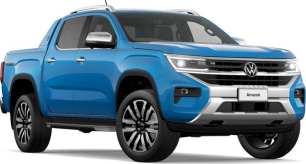The Amarok TDI500 is easy and effortless to drive on the open road. Peak power of 154kW (at 3750rpm) is adequate, but it’s the 500Nm of pulling power, delivered exactly where you want it at just 1750rpm, that sets the tone.
With 10 ratios to cycle through, the auto transmission also helps keep things in the sweet spot and while you’re aware of a certain amount of diesel thrum under acceleration, in this type of ute that’s more reassuring than annoying.
Suspension is by double wishbones and coil springs at the front with leaf springs supporting a live axle at the rear. And as is typical for a ute with this set-up (particularly unladen) bumps on a typical B-road make their presence felt, but not to an alarming degree.
We drove it on loose dirt roads and some challenging trails (which we’ll get to shortly), but overall it feels capable and pretty well planted on the road.
The steering is electrically assisted and there’s a good connection between your hands on the wheel and the tyres on the road.
Standard 17-inch alloys are shod with 225x70 Continental CrossContact ATR (all-terrain) tyres and they’re civilised on the highway. Also worth noting more aggressive off-road-focused rubber is a no-cost option, which is a nice touch.
The brakes are discs front and rear, which is notable because the entry-level Amarok Core is fitted with drums at the back.
On the open-road and in slow-going off-highway, where you’re constantly feathering the brakes during steep declines, braking remains strong with a progressive pedal feel.
The off-road section of the launch drive was more about the nature of the terrain than ultra-steep inclines or declines.
Big boulders, cavernous ruts, bulging tree roots as well as loose gravel and sand surfaces were the flavours of the day and the Amarok did a great job.
Standard approach, departure and ramp-over angles for the Life TDI500 are pretty solid, but an extra 40mm of ground clearance makes a big difference.
Worth noting the 10 Deserts Edition held its own with the more heavily modified V6 Style that set the Guinness record, which we also had a chance to steer.
With around 80kg less weight on the front axle, the four-cylinder feels agile and eager in the rough stuff and we saw some impressive axle articulation as the suspension and drive systems helped the Amarok pick its way through the most difficult sections.
We stepped our way through two-wheel high, four-wheel high and 4WD low modes, pulling in the diff lock only when things got hairy.
In terms of miscellaneous observations, it’s worth noting the turning circle is 12.8m. The Amarok is a sizeable vehicle and you’d expect the turning circle to be up there, but just be prepared for a reasonably wide arc when you’re parking or making three-point turns.
And the front seats are a stand-out. They’re pretty much sports editions - grippy and comfortable even after a full day behind the wheel on- and off-road. And their lateral support keeps you nicely located in the corners.

